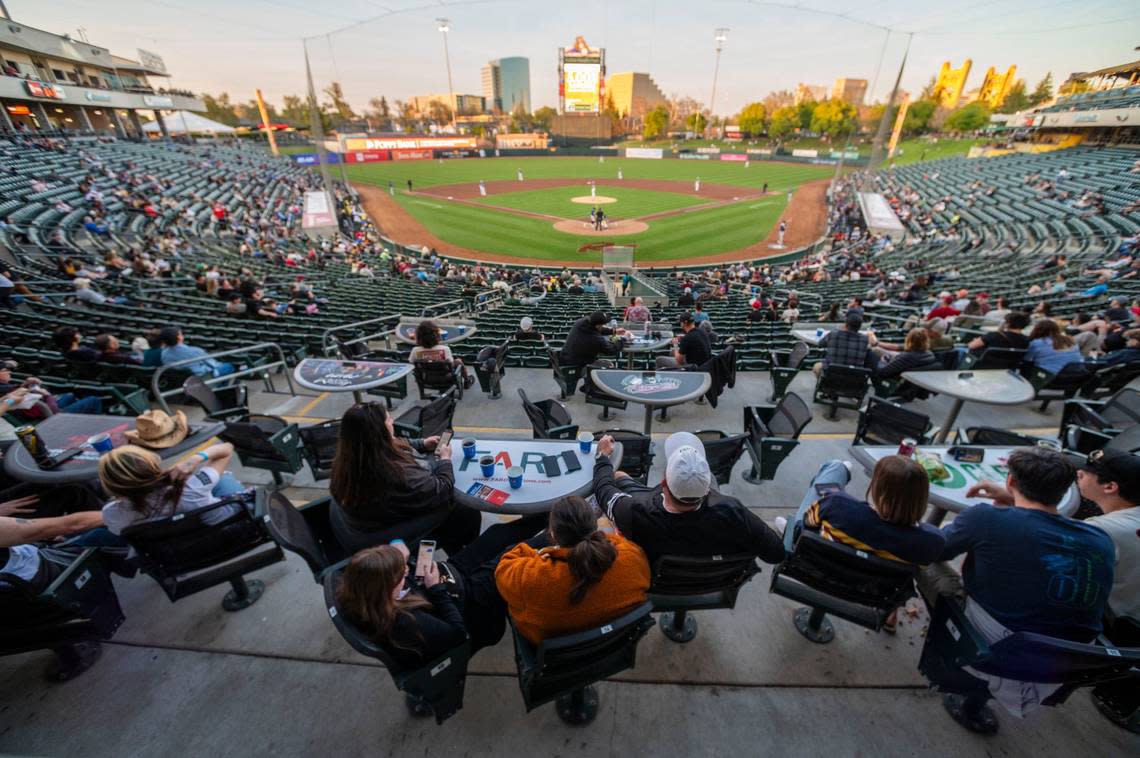Will scorching summer heat affect Athletics’ games in Sacramento? What MLB commissioner says

In the Spotlight is a Sacramento Bee series that digs into the high-profile local issues that readers care most about. Story idea? Email metro@sacbee.com.
As the Athletics prepare for their first season in West Sacramento to begin next March, concerns about how the summer heat will affect players throughout the season have been vocalized by many, including the head of the union representing Major League Baseball players.
MLB Commissioner Rob Manfred echoed and addressed those concerns earlier this week, which Tony Clark, executive director of the Major League Baseball Players Association, brought up as a potential health and safety issue for players.
Though they will have to share their new home field with the Sacramento River Cats, a Triple-A minor-league team, the San Francisco Chronicle reported that Manfred emphasized that discussions with the MLBPA hope to ensure a “vast majority of the games can be played at night when it’s cooler.”
Sacramento just experienced a record-breaking heat wave that was the hottest 20-day stretch on record in the city, according to the National Weather Service, with an average high temperature of 103.8 degrees.
Turf troubles
One way Manfred tried to dispel fears regarding the heat was with the confirmation of the type of artificial turf that will be installed at Sutter Health Park before the A’s make their move.
At an annual Baseball Writers’ Association of America luncheon last week, before the All-Star Game, Manfred talked about the planned turf: a product called BK1 made by Shaw, which is used in Arizona, Miami, Tampa Bay and Arlington.
“It has a specific hydration component to it in terms of water being added to it to cool the surface. We think that’s the best we can do in terms of playing surface in the heat with respect to day games,” Manfred said, according to the Chronicle.
The planned outdoor turf is expected to bring even more heat to the field, as turf can cause an increase in heat of 10 to 30 degrees compared to natural grass in direct sunlight. Though Florida and Arizona experience similar temperatures to Sacramento, the Tampa Bay Rays play at an indoor stadium, and the Miami Marlins and Arizona Diamondbacks play in stadiums with retractable roofs. That makes the A’s new home the only fully outdoor MLB stadium to use turf.
In addition to acknowledging the need for later start times and limited day games, Clark said he understands that modern turf has improved from rock-hard surfaces of the past.
“It’s important to acknowledge 106 degrees is still 106 degrees and a day game is going to resonate much differently than a late-morning game or an evening game if you’re going to be able to get on the field once the sun goes down,” Clark told the Chronicle earlier this week. “Those are all conversations that are ongoing and we are fully aware of.”
As The Sacramento Bee reported earlier this year, the turf will be installed to help keep up with the increase in wear and tear that comes with the 156 home games that could be played at the stadium, between the A’s and River Cats hosting — nearly double the 81 home games of a normal MLB season.
Oakland A’s owner John Fisher has plans for a new stadium in Las Vegas to host his team, but made a deal with River Cats and Sacramento Kings owner Vivek Ranadivé earlier this year for the A’s to play in Sacramento.
Ranadivé agreed to host the team for three to four years until they can make that move to Nevada. He hopes that this will prove that Sacramentans and the stadium are ready for a major league team of their own.
Shaw explains on its website that its fields “not only play like natural, but play like the surface the game should be played on.”
Unlike typical turf, the surface should not cause excessive bounce or feel very different from natural grass, Shaw claims.
Day games bring the heat
Clark expressed concerns for players’ safety during ball games on an artificial turf because of Sacramento temperatures, which have been consistently high recently and often reach triple digits in the summer. Even with co
“Decisions needed to be made sooner rather than later because there’s a lot of work to be done to assure the well-being of the players who are going to have to make adjustments to accommodate the decisions the league is making,” Clark said.
Manfred said that the league is hoping to limit day games throughout the 2025 season, which is set to start on March 31.
The MLB’s exclusive network broadcast window also necessitates day games on Sundays, which must start before 1:15 p.m. Pacific Time. The exception to this rule is the ESPN “Sunday Night Baseball” game.
When the team has to travel, more day games will need to make their way into the A’s schedule, as required by the league’s collective bargaining agreement. The league uses a formula to determine how early a game has to start, depending on whether a team travels more than 2 hours and 30 minutes in flight time and plays the next day, or has a home off day.
“In terms of constructing the schedule, we were very careful to try to limit the distances that would have to be traveled by clubs from Sacramento on getaway days and the hope we could get some flexibility on that getaway-day issue,” Manfred said.
Next year’s schedule was released by MLB on Thursday, but game times have not yet been confirmed.
The A’s schedule shows the team is slated to play two Sunday home games in June, two in July and three in August.
Some anticipated games, including when the Giants play the A’s on July 4-6, are likely to be hot days.

